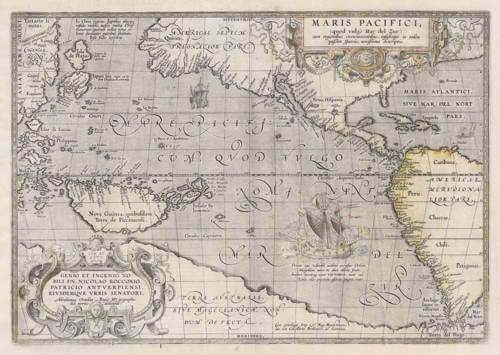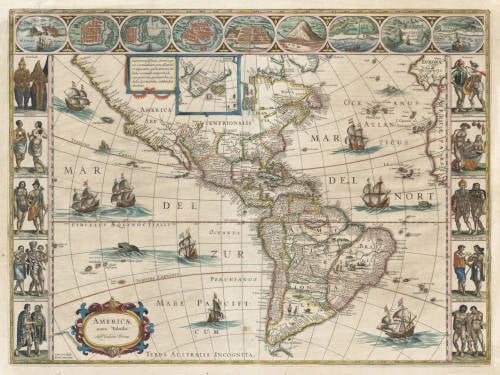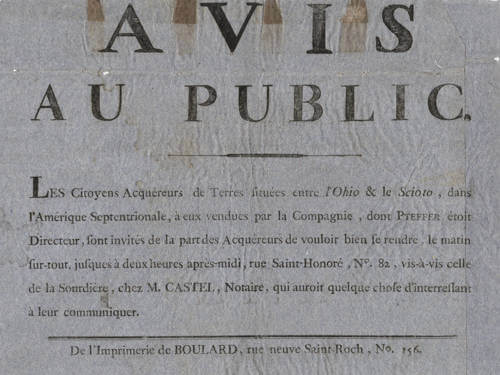Leen Helmink Antique Maps
Antique map of America by de Wit / Ottens
Stock number: 18882
Zoom ImageTitle
AMERICA
First Published
Amsterdam, 1662
This Edition
1730
Size
101.5 x 124.0 cms
Technique
Condition
mint
Price
$ 135,000.00
(Convert price to other currencies)
Description
Ottens issue of Frederick de Wit’s masterpiece wallmap. A Cartographical Landmark of America.
The legendary large Wall Map of America by Frederick de Wit, first published in 1662, here in its final state by Reinier and Josua Ottens ca 1730.
Printed on six sheets, total size 101.5 x 124 cm.
Mint condition. Strong and even imprint of the copperplates. Spectacular contemporary color.
A spectacular and very detailed wall map of the new world. Here in its final state with completely updated geographic rendering of the original colonies, at a time of rapid discoveries and settlements inland. While nearly all wall maps suffer from severe damage, this example is in perfect condition. A magnificent wall map of exceptional rarity and historical importance.
This exceptionally rare and important map of America constitutes the final state of the set of wall maps of the four continents, first published by the famous and successful Amsterdam publisher and map seller Frederick de Wit (1629-1706). Only the Europe map carries De Wit’s impressum and the date 1662 (example in Sächsisches Hauptstaatsarchiv, Dresden).
Of this set of wall maps, the America (1662 1st state examples in Boston Public Library and Dresden) was re-issued in 1672, showing De Wit’s address with this 1672 date (2nd state, Burden’s 1st state; examples i.a. in National Maritime Museum, Greenwich and Town Hall of Enkhuizen). Both of these early states show for the Great Lakes one big lake only, open to the west. The copperplates went through a new issue in 1700 (3rd state, Burden’s 2nd state; examples i.a. University Library, Amsterdam and Institut Cartogràfic de Catalunya, Barcelona). The folio map by Sanson played an important role in the revision of the geography. In Nova Francia, five lakes are now shown in the region of the Great Lakes, with the two westernmost lakes only partly drawn.
In 1710, a few years after the death of Frederick de Wit, a fund auction was held by his widow, including the sales of the copperplates of the four continents. They came in the possession of Pieter Mortier (1661-1711) who did not use them. In 1721, the copperplates were sold in auction by the heirs of his widow, and were acquired by the Ottens publishing house in Amsterdam. The brothers Reinier and Joshua Ottens worked in partnership ‘in de Weerelt Kaart’ (In the World Map) on the Nieuwendijk, from 1726 until Reinier’s death in 1750. With this address also appeared a re-issue of De Wit’s wall maps of the four continents. (4th state, Burden’s 3rd state). Burden mentions two examples of the America map (present whereabouts unknown) with a French title panel and the impressum of the Ottens brothers. Furthermore – as in the previous states – these maps were issued with city views in the side panels. It is possible that it concerns an unaltered re-issue of the De Wit state of 1700.
Josua and Reinier Ottens were not satisfied with the outdated geography of the America map. The copperplates went through a complete make-over transformation and the geographical content was substantially updated and changed. Many modifications were based on America maps published by Guillaume de l’Isle, including the Carte du Canada de la Nouvelle France (1703 and later). The Hudson Bay with neighboring areas and the Great Lakes region were heavily transformed, as was the Mississippi Valley. Notable is the insertion of the Rivière Longue, a fictitious western tributary of the Mississippi that was introduced by Baron de Lahontan in 1703.
On the De Wit states of 1662, 1672 and even 1700, the east coast of North America is dominated by Dutch toponyms, based on the early Dutch explorations and the Dutch province of New Netherland. The states of 1662 and 1672 even ignore the British colony of New England altogether, that British colony is not recognized by the Dutch at the time, in contrast to Virginia. The 1700 state does introduce N. ANGLIA, but still retains Nieu Nederland and Nieu Amsterdam, and dozens of Dutch names, even though it had been conquered by the British decades earlier.
In the final state offered here, New Netherland has disappeared. Little trace is left of the earlier Dutch presence, and dozens of Dutch names have disappeared. Adm. Blocx eyland remains, named after its first discoverer Adriaan Block in 1614. Cap Hinlope has however been added, as well as Orange. We now see the appearance of the British cities of Portmouth, Boston, Cambridge, Providence, N. Iork and Philadelphia. Inland hundreds of Indian and French names appear that would later find their way into modern names. The French le Detroit [du Lac Érie] is where Detroit would be founded later, and F. S. Louis is a remote French fortress.
Some old ideas survived in the geography, like the concept of California as an Island. In the lower left of the wall map, south of the Salomon Islands, Pedro de Quiros’ QUIRI REGIO now has a wide southern coastline resulting in a huge island. In the southernmost Atlantic Ocean, the mythical and fictituous Insula Saxenburg is drawn, with the explanation that this was discovered by the Dutchman Jan Leenderts Lindeman in 1670. The oceans are now augmented with trading routes (from the East Indies and West Indies to Europe; from China to Nova Hispania) and ocean tracks of famous explorers including Drake, Vespucci, Magellan, Cortez, de Mendana, de Sarmiento, van Noort, Schouten and Le Maire. The youngest dated track is Halley with year 1700. East of Magellan’s Strait are two little islands referring to recent discoveries of 1701 and 1705.
De Wit’s beautiful and elaborate title cartouche contains an explanation of an important navigation tool: an elegant mathematical procedure to calculate the distance on a sphere (the earth-surface) between two arbitrary places, given their coordinates of longitude and latitude. The paradigm uses Euclidean geometry with simple linear chords to replace and approximate spherical trigonometry, which in itself was well-developed but involved calculations that were too complex and time-consuming for most steersmen and navigators.
The Ottens brothers did not want to include the archaic city views panels of De Wit, that no longer fitted in the modern layout they envisaged. The result is a magnificent wall map of the Americas, with a complete transformation of the old geography, a geography that was still heavily in development by further explorations of the coasts as well as the interior. This final state must therefore be regarded as one of the benchmarks in the cartography of America.
(Schilder)
References:
C. Koeman, Atlantes Neerlandici (1967-71) pp. 85-86 and 191-192
R. Shirley, The Mapping of the World (1983) Entries 453 and 500
J. Werner, inde Witte Pascaert (1994) pp. 52-54
Hollstein (1999) pp. 31-32 (unacquainted with the Ottens edition)
P. Burden, The Mapping of North America II (2007), Entry 428 (showing in Plate 428 erroneously the De Wit state (1672) of the copy in the NMM, Greenwich)
Frederick de Wit (1629-1706)
Early Life and Beginnings in Amsterdam
Frederick de Wit was born around 1629 in Gouda, a city known for its cultural and intellectual contributions during the Dutch Golden Age. His family was Protestant, and by 1648, 18 or 19 year old De Wit had moved to Amsterdam, a city at the heart of Dutch trade, culture, and mapmaking. Here, he served his apprenticeship under the tutelage of Joan Blaeu, whose family was already famous for producing some of the world's finest atlases and maps.
Establishment in Amsterdam
In 1654, de Wit set up his own printing office and shop, initially named "De Drie Crabben" (The Three Crabs), which was also the name of his residence on Kalverstraat. The following year, he renamed it "De Witte Pascaert" (The White Navigation Chart), signaling his focus on cartography. His early works included a plan of Haarlem in 1648 and illustrations for Antonius Sanderus’s "Flandria Illustrata", but it was his independently engraved map of Denmark in 1659 that marked his entry into the broader mapmaking world.
Cartographic Contributions and Style
De Wit's maps were distinguished by their accuracy, decorative borders, and elaborate cartouches often depicting classical mythology or allegorical scenes. His most famous work, "Nova Totius Terrarum Orbis Tabula," was a world map first published in 1660. The map demonstrated his skill in both geography and artistic design. Over the decades, he produced numerous sea charts, town plans, and wall maps, which were not only navigational aids but also sought after for their beauty and decorative value.
By the 1670s, de Wit was producing larger atlases like the "Atlas Maior" and "Nieuw Kaertboeck van de XVII Nederlandse Provinciën". These atlases combined his own engravings with those he had acquired, showcasing his entrepreneurial spirit. His maps of the Netherlands were particularly notable for their detailed depiction of the Dutch landscape, including cities, waterways, and dykes, reflecting the country's complex relationship with its environment.
Personal Life and Guild Membership
In 1661, de Wit married Maria van der Way, which not only brought him personal happiness but also the privileges of Amsterdam citizenship. This allowed him to join the prestigious Guild of Saint Luke in 1664, which was essential for artists and engravers in the city. His involvement with the guild underscores his standing in the artistic community of Amsterdam.
Later Years and Legacy
De Wit's business thrived, especially after the death of his mentor Blaeu, from which he acquired many copper plates when they were dispersed at auction, positioning him as one of the leading cartographers in Amsterdam. He continued to expand his catalog, ensuring his maps were up-to-date with the latest geographical discoveries. His attention to detail and the aesthetic quality of his work made his maps popular among the elite, scholars, merchants, and navigators alike.
When Frederick de Wit passed away in July 1706, his wife Maria managed the business until 1710. After her death, the vast collection of copper plates was auctioned off, with many going to Pieter Mortier (1661-1711), who used them to further his own publishing empire, Covens & Mortier. In 1721, the copperplates were sold in auction by the heirs of Mortier's widow, and were acquired by the Ottens publishing house in Amsterdam. These transactions illustrate de Wit's lasting influence on the mapmaking industry.
Cultural Impact and Modern Appreciation
De Wit's work encapsulates the spirit of the Dutch Golden Age – a period of unprecedented artistic and scientific achievement. His maps are not merely tools for navigation but are also pieces of art that reflect the cultural pride of the Dutch in their maritime and cartographic prowess. Today, his maps are treasured in collections around the globe, from libraries to smaller, specialized map collections. They are frequently exhibited in museums as exemplars of the Dutch art of cartography, admired for their precision, beauty, and historical significance.
Frederick de Wit's legacy is one of a craftsman whose maps not only charted the physical world but also captured the imagination of those who used them, contributing to the enduring allure of an age when maps were as much about exploration as they were about art.
Joachim Ottens (1663-1719)
Reinier Ottens (son) (1698-1750)
Joshua Ottens (son) (1704-1765)
The family business of print and map selling was founded Joachim Ottens but the active period of ma publishing was concentrated in the years between 1720 and 1750 when the brothers, Reinier and Joshua, produced enormous collections of maps, some as large as 15 volumes. These, including copies of practically all maps available at the time, were made up to order and were magnificently coloured. Besides these specially prepared collections they also issued single-volume atlases with varying contents as well as pocket atlases.
(Moreland and Bannister)






